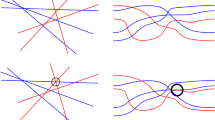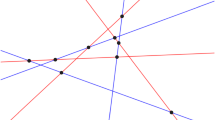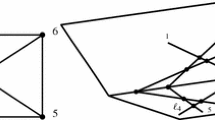Abstract
Aweaving W is a simple arrangement of lines (or line segments) in the plane together with a binary relation specifying which line is “above” the other. A system of lines (or line segments) in 3-space is called arealization ofW, if its projection into the plane isW and the “above-below” relations between the lines respect the specifications. Two weavings are equivalent if the underlying arrangements of lines are combinatorially equivalent and the “above-below” relations are the same. An equivalence class of weavings is said to be aweaving pattern. A weaving pattern isrealizable if at least one element of the equivalence class has a three-dimensional realization. A weaving (pattern)W is calledperfect if, along each line (line segment) ofW, the lines intersecting it are alternately “above” and “below.” We prove that (i) a perfect weaving pattern ofn lines is realizable if and only ifn ≤ 3, (ii) a perfect m byn weaving pattern of line segments (in a grid-like fashion) is realizable if and only if min(m, n) ≤ 3, (iii) ifn is sufficiently large, then almost all weaving patterns ofn lines are nonrealizable.
Similar content being viewed by others
References
B. Chazelle, H. Edelsbrunner, L. J. Guibas, and M. Sharir, Lines in space—combinatorics, algorithms and applications,Proc. 21st Annual ACM Symposium on Theory of Computing, 1989, pp. 382–393.
B. Chazelle, H. Edelsbrunner, L. J. Guibas, R. Pollack, R. Seidel, M. Sharir, and J. Snoeyink, Counting and cutting cycles of lines and rods in space,Proc. 31st Annual IEEE Symposium on Foundations of Computer Science, 1990, pp. 242–261.
H. Edelsbrunner,Algorithms in Combinatorial Geometry, Springer-Verlag, Heidelberg, 1987.
B. Grünbaum,Arrangements and Spreads, Reg. Conf. Series in Math., AMS, Providence, RI, 1972.
M. McKenna and J. O'Rourke, Arrangements of lines in 3-space: a data structure with applications,Proc. 4th Annual ACM Symposium on Computational Geometry, 1988, pp. 371–380.
J. Milnor, On the Betti numbers of real varieties,Proc. Amer. Math. Soc. 15 (1964), 275–280.
R. Penne, On line diagrams, Manuscript (1989).
R. Penne, Algorithms for line diagrams, Manuscript (1989).
R. Thorn, Sur l'homologie des varietes algebriques reelles, inDifferential and Combinatorial Topology (ed. S. S. Cairns), Princeton University Press, Princeton, NJ, 1965.
O. Ya. Viron, Topological problems concerning lines and points of three-dimensional space,Soviet Math. Dokl. 32 (1985), 528–531.
H. E. Warren, Lower bounds for approximation by linear manifolds,Trans. Amer. Math. Soc. 133 (1968), 167–178.
W. Whiteley, Rigidity and polarity II: weaving lines and tensegrity frameworks,Geom. Dedicata 30 (1989), 255–279.
W. Whiteley, Weaving, sections and projections of spherical polyhedra,Discrete Appl. Math., (1990), to appear.
Author information
Authors and Affiliations
Additional information
Communicated by Takao Asano.
Jànos Pach has been supported in part by Hungarian NFSR Grant 1812, NSF Grant CCR-8901484, and the Center for Discrete Mathematics and Theoretical Computer Science (DIMACS), a National Science Foundation Science and Technology Center, under NSF Grant STC88-09648. Richard Pollack has been supported in part by NSA Grant MDA904-89-H-2030, NSF Grants DMS-85-01947 and CCR-8901484, and DIMACS. Emo Welzl has been supported in part by the ESPRIT II Basic Research Actions Program of the EC under Contract No. 3075 (project ALCOM) and DIMACS.
Rights and permissions
About this article
Cite this article
Pach, J., Pollack, R. & Welzl, E. Weaving patterns of lines and line segments in space. Algorithmica 9, 561–571 (1993). https://doi.org/10.1007/BF01190155
Received:
Revised:
Issue Date:
DOI: https://doi.org/10.1007/BF01190155




